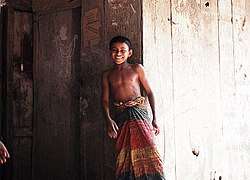Lungi
The lungi (/luŋɡi/) is a type of sarong that originated in the Indian subcontinent,[1] it is a traditional skirt-like lower garment wrapped around the waist, usually below the belly. Apart from India, lungis are also worn in Sri Lanka, Bangladesh, Pakistan, and Nepal. It is also known as a longyi in Singapore, Cambodia, Burma, and Thailand. The lungi is a particularly popular form of casual wear and night wear for men in regions where the heat and humidity of the climate make it unpleasant and uncomfortable to wear closed and tight garments such as trousers.[2]

Design
They are especially worn in hot regions. There are also cheaper "open" lungis, in identical dimensions but not sewn into a tube shape. The standard adult lungi is 115 cm in height and 200 cm in length, when open. Children's lungis are available in approximately 2/3 of this size. They are normally woven from cotton and come in a variety of designs and colors. Silk lungis are available for ceremonial purposes such as weddings. The most common styles are either solid-colored or plaid, reflecting the relative ease and cost-effectiveness of producing these patterns on a power loom. Blue is particularly popular, since it fades to pleasant tones in contrast to other colors. Regardless of the design or color, lungis are often lined at the top and bottom with a black/white stripe containing reinforced weaving to prevent fraying.

Usage
Depending on local tradition, lungis can be worn by men and/or women (rarely). They are tied or fastened in various ways, and can be used in different cultural activities, ranging from normal daily life to elaborate wedding ceremonies. For daily purposes, a simple "double twist" knot is most popular, where two points in the upper edge of lungi are brought together and twisted around twice, with the ends tucked in at the waist. However, it is also common for wearers to simply tie a double "pretzel knot" from 2 points on the upper border, which produces a more secure knot. The lungi's length can also be adjusted, for example, by tucking in the lungi at the waist to make it resemble a short skirt. This is mostly used for labourers who have to work for a long time under a hot sun.
Regional variations
India
In India, the customs behind wearing lungis vary by state. It could be worn with or without the traditional unsewn kaupinam or later-era sewn langot, both of which are type of traditional loincloth undergarments.

In Kerala, the lungi is generally colourful and available in various designs, and it is worn by both men and women. It is also called Kaili. Physical laborers typically use it as a working dress. A Kerala dhoti is plain white and known as mundu, and it often bears golden embroidery (known as "kasavu" mundu), especially at the border; it is worn as formal attire and on ceremonial occasions like weddings, festivals, etc. Saffron-coloured mundus are known as kaavi munde. The men sometimes tuck up their mundus (Kerala dhoti) or lungis with the bottom of the garment being pulled up and tied back on to the waist. This would mean that the mundu (Kerala dhoti) or lungi only covers the body from the waist to the knees.
In Andhra Pradesh, Telangana, Karnataka and Tamil Nadu, only men wear this garment, and it is worn slightly differently from men in Kerala; Keralites tie the mundu to the right side, while the Tamilians tie it to their left. However, there are exceptions and some of the Muslim communities in Kerala also tie the mundu to their left. It is also known as "Kaili" or "Saaram/Chaaram" in South Tamil Nadu.
In Tamil Nadu Dhoti is considered as a traditional informal or casual wear and also preferred as a comfortable night wear. Lungis with checked pattern are more popular. A white-colored open cloth called vesti (dhoti) and is used in formal occasions.
It is common in Konkan side of Karnataka state. Mostly used by Nawayath people who hails from Bhatkal Almost all of them wears it as their daily attire. It is as a mark of their tradition in Bhatkal. Mostly you will find them sewn like cylindrical shape.
In Punjab (both Pakistani and Indian portions), lungis are worn by both men and women. The male lungi is also called a tehmat,[3][4] while the female lungi is called a laacha. They are part of traditional dance attire in Bhangra dance groups, but are also popular in rural areas as home wear. They are generally tied in a different way than in other parts of India and are, as a rule, unstitched and very colourful. Wearing the lungi has declined in the Punjab region in recent years.[5]
In Odisha, and West Bengal the lungi is primarily worn at home by males of all classes of society. Hindu men generally avoid wearing lungis on the street. In Odisha, Sambalpuri with the Sambalpuri pattern and mule based lungis from Khordha are available in addition to normal cotton fabric lungis.
In Bihar and Haryana the lungi is considered a night garment for men.
In Jharkhand, Chhattisgarh and Madhya Pradesh the lungi is worn often by Tribals. They have shifted to this from their previous dress of a small cloth around their waist.
Sultanate of Oman
In the Sultanate of Oman the garment is referred to as a "wizar" it is worn in all regions by men and is recognized as an undergarment to the traditional Omani "dishdasha". It is wrapped around the waist quite differently to the Indian style as it is folded left then right to make a straight seam in the middle. The wizar is usually white (north of country)with a colourful border of different colors. The wizar can be worn as an in house garment as most Omani's simply remove their dishdasha when at home and relax in their "wizars" and vests. In the South of Oman in the region of Dhofar it's common to see a colorful varieant of the wizar and is worn more openly outdoors than it is in the north.
Bangladesh

The lungi (Bengali: লুঙ্গি /luŋɡi/, Sylheti: ꠟꠋꠉꠤ /lonɡi/) is the most commonly seen dress of Bangladeshi men, although it is not normally worn for formal occasions. In Bangladesh, lungis are worn by men, almost universally indoors, but commonly outdoors as well. Elaborately designed tartan cotton, batik, or silk lungis are often presented as wedding gifts to the groom in a Bangladeshi wedding. The typical Bangladeshi lungi is a seamless tubular shape, as opposed to the single sheet worn in other parts of South and Southeast Asia. In Bangladesh, the lungi industry is concentrated in Sirajganj, Kushtia, Pabna and Khulna. Bangladeshi women do not traditionally wear lungis, although non-Bengali tribal women do wear similar garments in the Chittagong Hill Tracts.
In April 2013, the Baridhara Housing Society—a housing society in Dhaka—banned lungi, and began refusing entry to those who wore them. Many opposed the ban, however, taking to social media sites such as Facebook and Twitter to criticize the decision. A march took place on 13 April to oppose the ban. U.S Ambassador Dan Mozena has been seen wearing a lungi in front of his house.[6]
Myanmar
In Myanmar, it is spelt longyi. For men, the longyi is known as a paso (Burmese: ပုဆိုး), and for women, it is known as a htamein (Burmese: ထဘီ). Longyis of different fabrics, including cotton and silk, are worn for both informal and formal occasions.
Thailand
In Thailand, it is known as a "pa kao mah" (Thai: ผ้าขาวม้า) for men and a "pa toong" (Thai: ผ้าถุง) for women.
In popular culture
In 2013, a song called "Lungi Dance" was made and used as a promotion song. It was written, composed and sung by the rapper Yo Yo Honey Singh and starred himself along with Shahrukh Khan and Deepika Padukone.
External links
| Wikimedia Commons has media related to Lungi. |
References
| Wikimedia Commons has media related to Lungi. |
- Mohsen Saeidi Madani (1993). Impact of Hindu Culture on Muslims. M.D. Publications Pvt. Ltd. pp. 141–. ISBN 978-81-85880-15-0.
- http://www.hindustantimes.com/delhi-news/delhiwale-the-lungi-aesthete/story
- Development: A Saga of Two Worlds: Vismambhor Nath 2002 (Ashok Mukar Mittal Publishers)
- Lahore: A Sentimental Journey Pran Neville Penguin Books
- Alop Ho Reha Punjabi Virsa Harkesh Singh Kehal
- Priyo Photo share a moment! (2012-12-30). "US Ambassador Mozena | Priyo Photo". Photo.priyo.com. Archived from the original on 2013-05-08. Retrieved 2013-05-03.